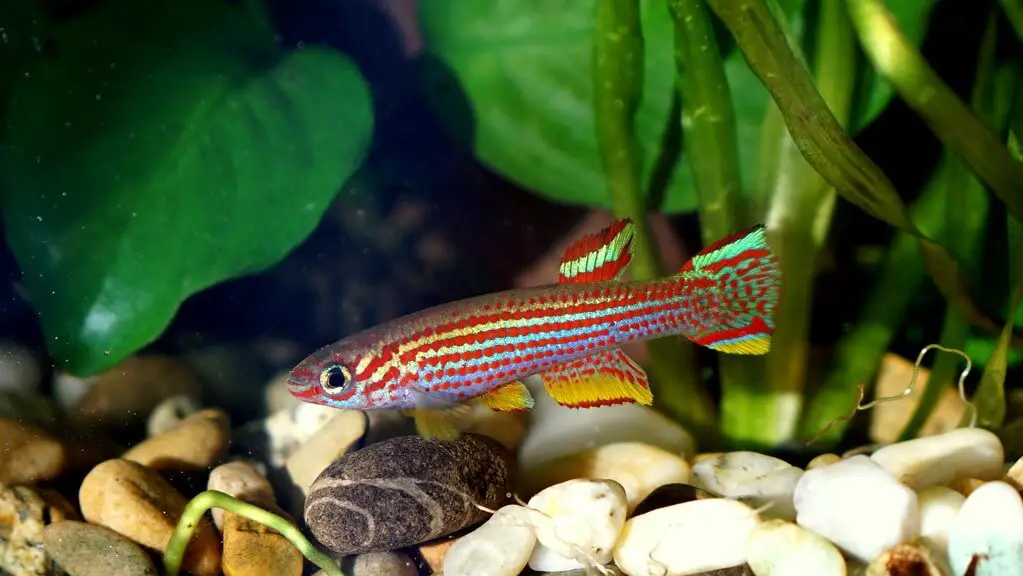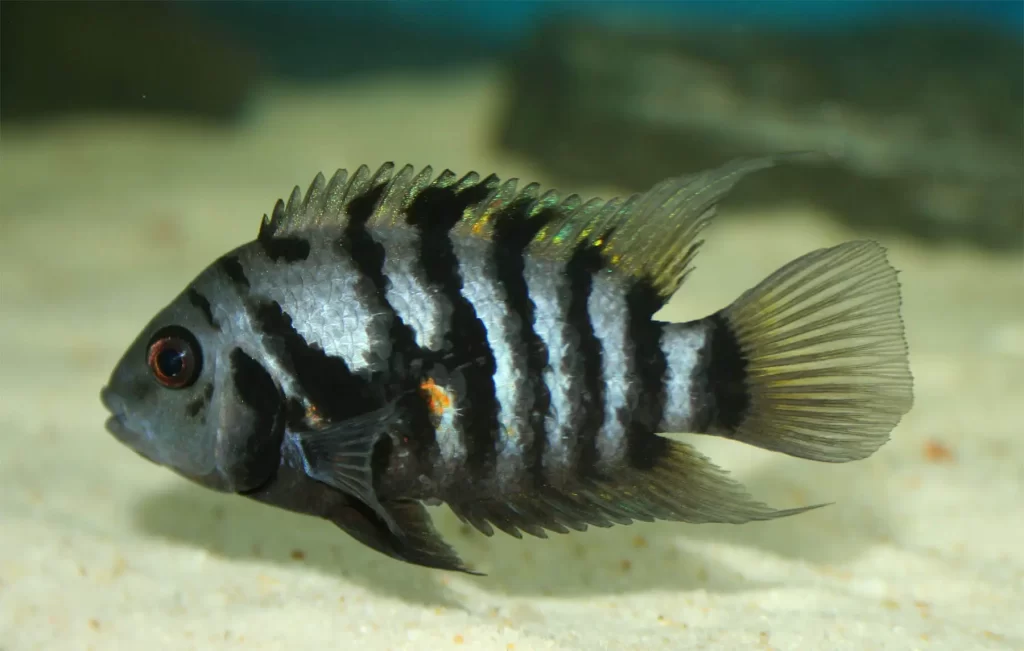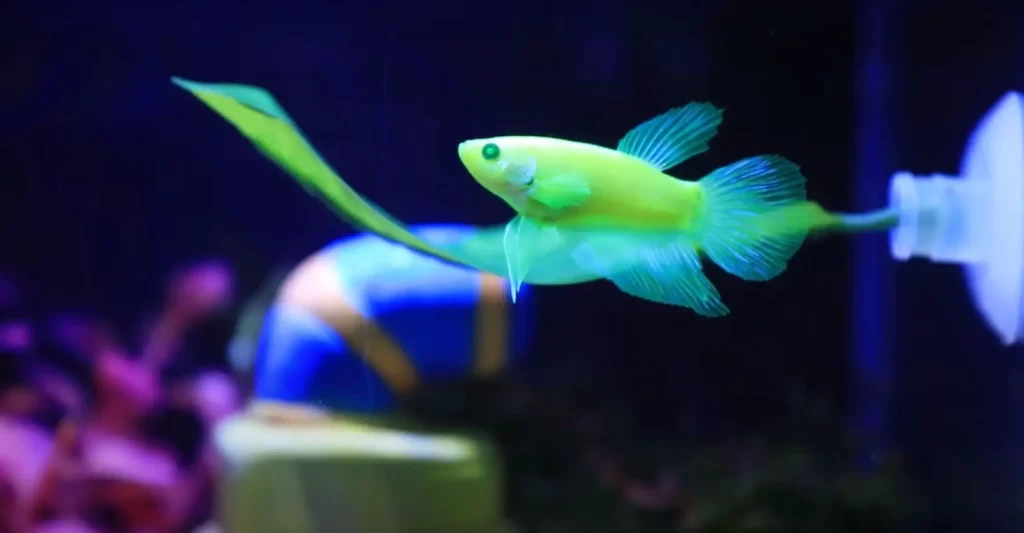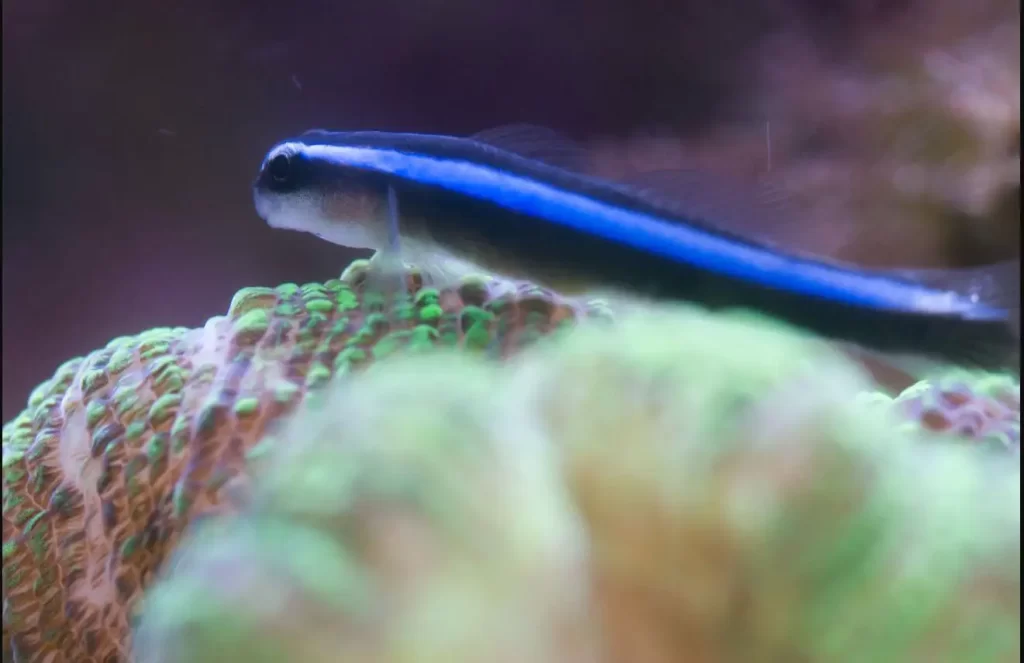I went to my local fish store today to get some regular supplies. Right in the corner was a unique finned vibrant species of fish I had never seen before, known as Killifish. I needed to know all about Killifish because then and there I knew I wanted to get the fish, but it required some research in order to provide a proper environment for my new pet Killifish. In this article, I will be sharing with you all about Killifish that I have gathered for having Killifish as my new pet.
The particular fish I saw in my local store was the Golden Wonder Killifish(Aplocheilus lineatus). But this article includes detailed aspects of over-all Killifish species that you need to know before you plan to get a pair for yourself. Let’s start by knowing about the fish in detail.
Killifish: A Brief Introduction
Just like performing a background detail on your personal assistant, this introduction will give you the idea of what a Killifish actually is.
Origin
The word killifish is said to be derived from the Dutch word ‘kil’ meaning a small stream or creek. With a range of species exceeding more than 1250 in number, the Killifish is an oviparous (egg-laying) Cyprinodontiform. Also known as ‘egg-laying topminnow’, the fish range in sizes and colors.
Killifish are inhabitants of shallow sub-tropical & tropical waters of 5 continents except for Antarctica and Australia. They are found in freshwater, brackish water as well as hot dessert water.
Distribution
Only a certain breed of Killifish like the Clown Killifish is captively bred. It is rare to find Killifish for sale in regular fish or pet stores. However, they are available online, at breeders and hobbyists, as well as at auctions.
But, other species caught for observation or research purposes are caught wildly.
Appearance
Killifish are one of the most attractive fish you can find, which is why many aquarium hobbyists like o keep them. With a wide range of exquisite species, Killifish is known for its distinctive body patterns and vibrant colors.
However, you can identify a Killifish with its characteristics that include a slim and pike-shaped body, the mouth located at the face tip or beneath it, curved, pointed, and long teeth, and round scales.
All species of Killies possess a dorsal fin pointed towards the back of their bodies and have bright colors with vivid patterns. Besides this, some have a cylindrical and long body and many have broad and long fins, depending upon the species.
Size
Usually, Killifish vary from 1 – 4 inches in size. However, there are larger species of Killifish that can vary from 6-10 inches in size. The hummingbird Lampeye(Poropanchax Myers) and the dwarf madeka (Oryzias minutillus)are some small-sized Killifish whereas Striped Panchax(3.9 inches) and The Orestias (Orestias cuvieri) is a larger one.
Availability
Most species are available in the market(online). However, the most common breed of Killifish includes Lampeye killifish, Striped panchax, Banded lamp eye, Delta killifish, Desert pupfish, and Japanese rice fish.
Price
A single Killifish can range anywhere from $6 – $20 depending upon the species. It is ideal to keep a group of 3 which will cost somewhere from $18 – $60.
Lifespan
There no certain lifespan of killifish. Some species of Killifish have a lifespan of 3-5 years, while some have a lifespan of 6-9 months. This is because the lifespan varies according to the origin of the fish and how they have adapted.
Sexual Difference
Killifish exhibit sexual dimorphism in the sense that the males are much brighter than the females and have larger dorsal and anal fins. The females, on the other hand, are faded gray and have shorter fins. This is the most basic way to distinguish between a male and a female Killifish.
Social Behavior and Tankmates of Killifish
Killifish are peaceful temperamental species which makes them a good community fish. You might be worried as the name of the fish is associated with the word kill, however, killing other fish is not something you need to be concerned in an aquarium for this species.
However, they are territorial in nature. Therefore, it is not ideal to keep males that look similar or are of a different breed of Killifish as this might lead to fight and bullying. Aggressive behavior can be exhibited by your Killifish if it feels threatened.
There is one more active behavior of Killifish that anyone planning to keep the fish must know, i.e ‘the jumping behavior’. Almost all species of Killies are good jumpers, so they can jump from even the smallest holes. It is important that you keep a secure lid so that none of your fish commit suicide.
Killifish are compatible to be ket along with similar-sized fish like:
- Neon, RummyNose Tetras
- Danios
- Rasboras
- Rainbows
- Apistos
- Smaller catfish etc.
Although Killifish tend to devour what fits in their mouths like shrimps.
Fish Keeping Difficulty
Killifish is known for it’s hardy, adaptive as well as easy-going nature. Belonging to more than 1250 species, each species is unique and has its unique requirements. Although the differences, these fish are well known to have acclimated to the local water conditions as of being captively bred.
Killifish is a fairly easy breed of fish that an aquarist can have. However, it is recommended that you have some level of experience (at least 2 years) in fish keeping. This is because the Killifish can exhibit some characters that all of us might not be able to handle.
But, if you’re in for something new, then this species is the one for you. Fear not because they only have a few extra requirements.
Killifish Care Tips: All you need to know
Aquarium
On average, a small Killifish can size up to 4 inches and are kept in a number of 3. This is the reason why most aquarists prefer keeping Killifish in nanto tanks (5-10 gallons). However, there are species like Blue Gularis (Fundulopanchax sjoestedti) that may grow up 5-6 inches. And bigger species require at least a 20-gallon tank.
Most Killifish are kept in a trio or even just a pair because mature Killifish are territorial. This prevents cross-fertilization. But, if you do want to keep more Killifish or a community tank, then make sure you have a bigger tank with lots of space. Besides this, it’s better to keep similar-looking Killifish species in different tanks.
Also, have a tank with a secure lid system as these jumpers might end up giving you some trouble.
Lighting
Killifish prefer a dim environment, much like Tetra fish. They are found in vegetative areas as well as other dry areas as well. However, subtle subdued lighting is the perfect setting for any species of Killifish.
It is not difficult to re-create a similar environment with artificial lights and plants as you can have control over the amount of light. For spawning purposes, the intensity of light can be increased as this induces activeness.
Decor and Substrate
Having plants in the tank can be of great advantage to plant-spawning Killifish. Live plants ensure nutrients like cellulose and lignin, which help in the digestion of the fish.
Different species of Killifish are distributed in different environments and are adaptable. This makes decorating the tank specific to the species of the Killifish. However, all Killifish will appreciate a well-planted tank. You can use plants that can tolerate less light like
- Cryptocoryne,
- Anubias,
- Java Moss, and
- Java Fern, etc.
Besides this, a driftwood set-up will be the perfect resemblance to most tropical climate.
A sandy substrate is the best option to have for a Killifish. The darker shaded sandy substrate will help enhance the vividly patterned and colored species even more, thus adding an aesthetic appeal.
Diet
A well-balanced and varied diet of live food is the go-to method of having healthy fish.
The diet can consist of items like Daphnia, Tubifex worms, Brine Shrimp, Mosquito Larvae, black worms, white worms, and even beef heart, dried fruits, paste food, and fruit flies.
Killifish are carnivorous creatures and have a live food requirement. For this reason, you cannot feed them with herbivorous food like pellets. They are picky eaters, for most of them, they will readily eat anything that is living you feed them. Most aquarists even prefer a home-made diet for their fish.
As for the fry, if you plan to breed your Killifish, micro-worms, vinegar eels, and infusoria are an ideal food. Adult food cannot be fed to the fry, but you can grind the adult food or give the fry egg yolk in powdered form.
Tip: To avoid over-feeding, feed your fish what they can consume in a specified time and always clean up the left-over food.
Water Quality Maintenance
Maintaining the quality of water for fish is an important part of maintaining a healthy and visually appealing aquarium. For this, you need to take care of parameters that include temperature, chemical compositions, changes as well as filtration.
Temperature
Having a suitable and regulated temperature in an aquarium is essential to not trigger a biochemical reaction in a fish’s body.
Usually, Killies can survive at a temperature between 70°F -80°F, which is pretty warm given they are from tropical and sub-tropical climates. Besides this, some species are even from deserts which makes them capable of surviving a hot climate.
You can also make use of light-weighted, corrosion-resistant, and reliable heaters in order to maintain the temperature.
pH and Hardness
pH and Hardness are chemical compositions that need to be an exact specification for any fish. A slight change can affect your fish by a multiple of 10. pH determines the acidic nature of the water whereby hardness determines the number of dissolved elements in the water.
The average level of pf pH for Killifish is between 6.0- 7.0. This level of pH for Killifish is very important as it might cause stress which leads to diseases and death. Because they are found in both freshwater and saltwater, the requirement is an exact thing you must know despite them being hardy.
Water hardness of 120-160 ppm is preferred by many species of Killifish.
Filtration
Having a proper filtration system ensures that your tank is well maintained and is protected from diseases and algae. Having an efficient filter with flowrates according to the liking of your fish can show better results.
For Killifish, sponge filters or simple box filters are the best and efficient choices. You should consider filter wool as the media for smaller tanks. Besides this, under-gravel filters can also be used for larger aquariums.
Thie filters in aquariums consist of good bacteria that help convert toxins.
Water Changes
Water Changes can range from partial to full changes. A partial water change must be maintained once a week in a proportion of at least 20% for the best results. Once or twice a month, full water changes can be performed. However, it’s best if you are experienced with full water changes.
When you perform water changes, the good bacteria in your aquarium can decrease hence causing the rate of the toxin to build up For this, you can look upon my article on how to grow good Bacteria.
Killifish Diseases
In the case of adult Killifish, the infections are mostly bacterial in nature and appear as cloudy patches. This is mainly because of getting struck by another fish. In the case of parasitic infections, there can be various causes. Usually, it can be caused due to poor water conditions which can be controlled as well as prevented.
The fry of this species is most susceptible to Velvet. This disease is caused during the early stages of life as they are kept in a tank where water changes are not made thus increasing the pH level.
Some common Killifish Diseases are:
- Gut thinning or loss of appetite,
- Cotton wool disease,
- Water Hydra,
- Velvet,
- Ich, and
- Fin rot
The solution is to provide a salt bath in the early stage of detection. Controlling the diseases not only prevents diseases but also intervene when new diseases are discovered.
Prevention for spreading of the disease can be done by keeping the fish in the quarantine or the healing tank.
Tip: Always have medical kits in hand and identify the diseases before looking for a cure.
Breeding Killifish
Killifish are very easy to breed in spite of their small size. This is the reason why they are popular among aquarists.
When it comes to breeding, this fish is easy- going and highly fertile. They are not entitled to specific breeding conditions. They become sexually mature in two months of their life cycle and can lay up to 30 eggs in a single day. And this cycle is repeated once a year or even frequently in 3 months. For healthy breeding, the Killifish must be well cared for and fed a nutritious diet.
Breeding Requirements
The breeding conditions required are:
- A small tank of capacity greater than 2.5 gallons- 5 gallons for a pair.
- A well-planted tank with Java moss and java fern along with low lighting.
- A pH ranging from 6.0 to 7.0 and the temperature between 68°F and 75°F.
- The total hardness between 7° and 10°( approx. 120 ppm-160 ppm).
- 10% water change a weekly basis.
Besides this, you must know about the type of breeders you have. Not all Killies prefer the same environment. Some might prefer depth, isolation, or even surface spawning. The two types of Killifish spawners are soil spawners and plant spawners.
Soil Spawners
Soil spawners are Killifish which prefer laying eggs in the soil. For this purpose, keep a sterilized peat moss layer in your breeding tank.
Matured Killies can begin the spawning process immediately when they find a suitable environment.
You will know when the mating process has occurred when the fish stay motionless and will part ways with jerking movement. Peat-spawner Killies will lay their eggs slightly below the surface and the peat-divers will lay their eggs deep in the peat.
For egg collection, the peat moss must be lifted gently and dried and then stored in a bag within a regulated temperature of 70°F – 75°F for 3 or more weeks.
Some eggs of Killifish are required to be provided with drying up the incubation period, while some prefer water incubation.
Plant Spawners
Breed like Aphyosemion, Fundulopanchax, Aplocheilus, Epiplatys, and Pachypanchax are plant spawners that like laying eggs on plants.
For such Killies, the mop method can be used. Made up of nylon or acrylic, a clean mop like green structure will mimic a spawning bed for the fish to lay their eggs on. The eggs can be separated after a few days.
Mimicking the natural environment can encourage the fish to spawn and the fry to hatch quickly.
Tip: Always remember to take out infertile eggs as they might decay later ending up polluting the fry tank.
All About Killifish: A Summary
Summing up on this colorful species, the following table describes Killifish in short.
| Category | Description |
| Care Level | Easy-Difficult (species dependent) |
| Origin | All 5 continents except Antarctica and Australia |
| Temperament | Mostly peaceful |
| Lifespan | 3 months – 5 years (species dependent) |
| Size | 4 inches (average) |
| Diet | Carnivorous (live food) |
| pH level | 6-7 dGH |
| Temperature | 70-80°C |
| Family | Cyprinodontiformes |
| Minimum Tank Size | 10 Gallons per pair |
| Compatibility | Community safe |
| Breeding | Easy |
Conclusion
An easy go-to breed for most hobbyists which is visually appealing as well is the Killifish. They are not that hard to keep unless you provide them with their suitable environments and are highly adaptable.
I hope this article has provided you with all the basic information you need to know before you purchase a Killifish.






